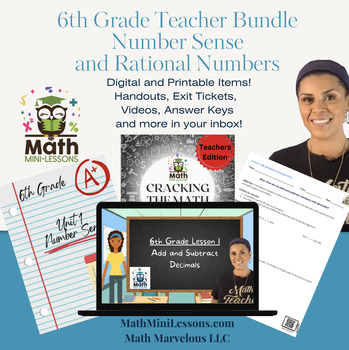6th Grade Number Sense and Rational Numbers Unit
Math Mini-Lessons
5 Followers
Resource Type
Standards
CCSS6.NS.A.1
CCSS6.NS.B.2
CCSS6.NS.B.3
CCSS6.NS.B.4
CCSS6.NS.C.5
Formats Included
- PDF
- Internet Activities
Pages
200+
Math Mini-Lessons
5 Followers
Compatible with Digital Devices
The Teacher-Author has indicated that this resource can be used for device-based learning.
Description
A complete 6th Grade Number Sense Unit neatly organized on one PDF. This PDF contains hyperlinks for all instructional materials for each lesson. This unit contains 26 lessons (55-75 minute lessons). Each lesson includes
- Printable Student Handouts
- Printable Exit Tickets and Mid-Lesson Assessments for Flexible Grouping
- Google Slides with data reviews from ETs or assessments
- Instructional Videos with teacher models for review or flipped classroom
- Corresponding digital lesson on GoFormative
- Teacher Notes and Answer Key
Also provided is a complete unit overview, a PreTest, PostTest, 4 Quizzes and Student Reflections for each assessment.
Answer Keys also added on GoFormative for instant data and student feedback. 30 Day free trial of GoFormative.
Total Pages
200+
Answer Key
Included
Teaching Duration
1 month
Last updated 3 months ago
Report this resource to TPT
Reported resources will be reviewed by our team. Report this resource to let us know if this resource violates TPT’s content guidelines.
Standards
to see state-specific standards (only available in the US).
CCSS6.NS.A.1
Interpret and compute quotients of fractions, and solve word problems involving division of fractions by fractions, e.g., by using visual fraction models and equations to represent the problem. For example, create a story context for (2/3) ÷ (3/4) and use a visual fraction model to show the quotient; use the relationship between multiplication and division to explain that (2/3) ÷ (3/4) = 8/9 because 3/4 of 8/9 is 2/3. (In general, (𝘢/𝘣) ÷ (𝘤/𝘥) = 𝘢𝘥/𝘣𝘤.) How much chocolate will each person get if 3 people share 1/2 lb of chocolate equally? How many 3/4-cup servings are in 2/3 of a cup of yogurt? How wide is a rectangular strip of land with length 3/4 mi and area 1/2 square mi?
CCSS6.NS.B.2
Fluently divide multi-digit numbers using the standard algorithm.
CCSS6.NS.B.3
Fluently add, subtract, multiply, and divide multi-digit decimals using the standard algorithm for each operation.
CCSS6.NS.B.4
Find the greatest common factor of two whole numbers less than or equal to 100 and the least common multiple of two whole numbers less than or equal to 12. Use the distributive property to express a sum of two whole numbers 1–100 with a common factor as a multiple of a sum of two whole numbers with no common factor. For example, express 36 + 8 as 4 (9 + 2).
CCSS6.NS.C.5
Understand that positive and negative numbers are used together to describe quantities having opposite directions or values (e.g., temperature above/below zero, elevation above/below sea level, credits/debits, positive/negative electric charge); use positive and negative numbers to represent quantities in real-world contexts, explaining the meaning of 0 in each situation.





